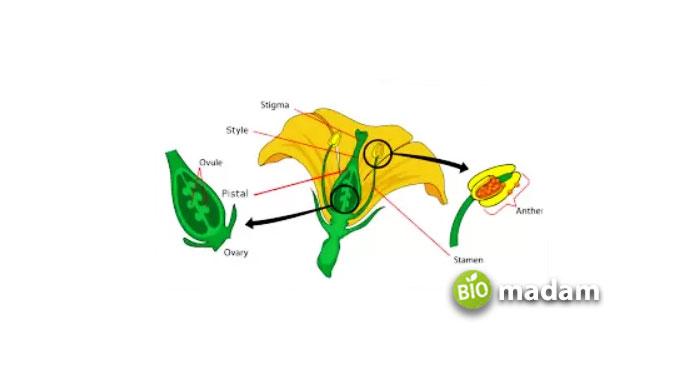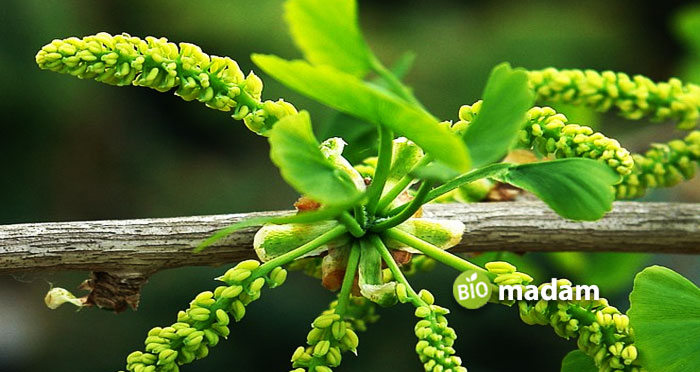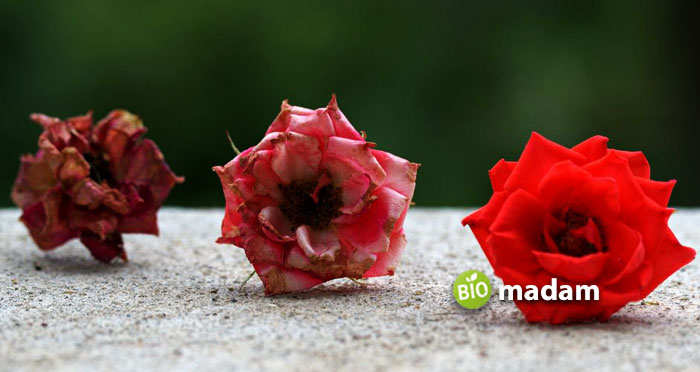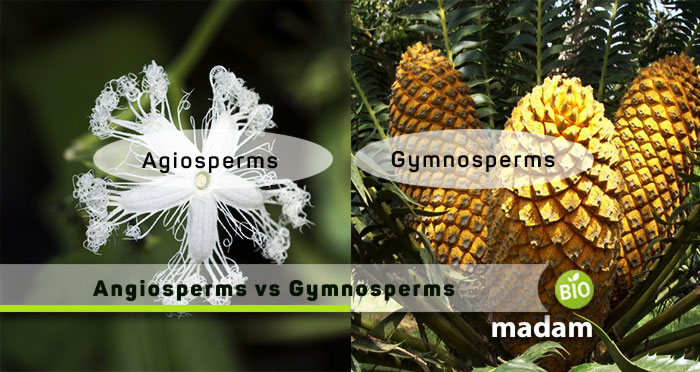Angiosperms and gymnosperms are the two primary names often heard when discussing plants! These are the seed-bearing flowering plants, where the former is thought to be more advanced than the latter. There are several differences between the two species, but the most prominent is the difference in diversity.
Angiosperms are more diverse with greater adaptability to the terrestrial ecosystem than gymnosperms. Let’s step ahead to grab more details about the two.
Comparison Table
| Parameters | Angiosperms | Gymnosperms |
| Nature | Herbs, shrubs, or trees | Mostly trees |
| Xylem Vessels | Present | Absent |
| Flowering Plant | Yes | No |
| Cone | Absent | Present |
| Style & Stigma | Present | Absent |
| Nature of Seeds | Enclosed Seeds | Naked Seeds |
| Double Fertilization | Present | Absent |
| Wood | Hardwood | Softwood |
| Life Cycle | Seasonal | Evergreen |
| Number of Tissues | Triploid | Haploid |
| Cotyledons | Monocots/Dicots | Absent |
Define Angiosperms
Angiosperms are a large group of seed-producing flowering plants characterized by the enclosure of seeds within the flower’s female reproductive organ. This reproductive organ is called the carpel, a collection of the ovary, style, and stigma. Furthermore, such plants have three main fruit wall layers: exocarp/epicarp, mesocarp, and endocarp. Typical examples include grasses, herbs, shrubs, bushes, and most trees.

Angiosperms constitute the largest and most diverse group within the plant kingdom, with approximately 300,000 species worldwide. They also represent about 80 percent of all the green plants on earth.
Define Gymnosperms
Gymnosperms are a group of plants characterized by being flowerless. The botanists’ oldest gymnosperm fossils are about 305 million years old. The word “gymnosperm” means “naked seeded.” These plants produce cones and seeds instead of flowers. Contrastingly to angiosperms, the seeds of gymnosperms are not enclosed in an ovary or carpel.
These plants have about 1000 living species distributed in various world regions. Moreover, gymnosperms constitute four species: Coniferophyta, Cycadophyta, Ginkgophyta, and Gnetophyta. Typical examples are Pinus sp., ginkgo, and cycads. Out of these, conifers constitute the most abundant extant group of gymnosperms, embedding a great variety of the group.

Similarities between Angiosperms and Gymnosperms
As both are categories of plants, so they have a few similarities, as discussed below:
- Both have special vascular tissue system, comprising of xylem and phloem. The phloem of both plants has companion cells.
- There is the formation of endosperm before fertilization occurs in both plants.
- Both plants have several types of leaves, roots, and stem as major body parts.
- Moreover, the origin of the seed and ovule is similar in both.
Differences between Angiosperms and Gymnosperms
Although both are seed-producing pants, they are quite different from each other. Consequently, let us take a look at them one by one.
Evolutionary Differences
In the early classifications by plant scientists, all the seed-producing plants were placed in a single group. However, with the advent of knowledge and research, it became evident that the two types cannot take a single hold in the plant kingdom.

Angiosperms
It is believed that angiosperms or flowering plants have emerged relatively recently compared to gymnosperms. The only earliest fossils of these recognizable plants are pollen grains in rocks.
The very first angiosperms are assumed to be probably small trees or shrubs and hold evolutionary transformation from gymnosperm via a complex series of events. The most obvious among these events could be the conversion of the sporophylls of gymnosperms into primitive stamens and carpels, which we see in today’s flowering plants.
Gymnosperms
Fossil evidence from recent research points to the fact that many seed plants were present before any evolutionary advancements, e.g., the origin of seeds, cones, vascular cambium, vessels, primary, and secondary growth. Therefore, some scientists think it is not appropriate to keep both in the same division, while many others have opposite views.
Plant divisions
Angiosperms
Unlike gymnosperms, angiosperms only have a single division called Magnoliophyta/Anthophyta.
Gymnosperms
Similarly, the commonly accepted divisions of the gymnosperms are Coniferophyta, Cycadophyta, Ginkgophyta, and Gnetophyta.
Leaves
Angiosperms
The leaves of angiosperms mostly have a flattened structure. Angiosperms have monocots and dicots as cotyledons. Furthermore, the veins of the leaves of dicots form an interconnecting meshwork while those of the monocots are parallel and do not interconnect.
Gymnosperms
Quite contrastingly, the leaves of gymnosperms are mostly scaly or needle-like in appearance.
Wood Structure
Angiosperms
Angiosperms have an inhomogeneous wood structure in a more varied form. Typically, there are two types of vessel arrangements in them. In the first, the wood contains scattered pores, while in the other, it has ring-shaped pores. Moreover, the angiosperm contains medullary rays, except that they are larger.
Another difference is that the rays of angiosperms do not contain tracheids as frequently as they are observed in gymnosperms. Also, there are various ways in angiosperms in which both single- and multi-layers are present in different species.
Gymnosperms
Gymnosperms have a homogenous wood structure which is pretty simple. The only conducting elements are the tracheids (except for a few species). Tracheids belong to a type of water-conducting cells present in the xylem tissue of plants and have no perforations in the cell wall.
In many species, gymnosperms woods are distinguished by the presence of heartwood or sapwood. While an active conducting water channel characterizes sapwood, the heartwood is inactive and thus does not perform any water conduction.
Moreover, the wood of gymnosperms is often interspersed with medullary rays at regular distances. Since they are oriented horizontally, they typically perform the function of horizontal conduction of the solutes.
Perennial v/s Annual
Angiosperms
Since angiosperms are flowering plants, they are mostly annual or biennial plants, meaning that they complete their life cycle annually or every two years, respectively.
Gymnosperms
On the other hand, since gymnosperm plants are woody, they are mostly perennials in nature. A perennial plant lives for many years and lasts for a period longer than one or two.
Reproduction
Gymnosperms and angiosperms also differ in their reproduction cycles and systems. The key differences are as follows:
Angiosperms
The angiosperms contain a female gametophyte in an ovule enclosed in a specialized structure of the flower called the ovary. Thus, the life cycle of angiosperm reproduction is characterized by double fertilization. Furthermore, the male and female gametophytes are part of a single structure, i.e., flower in angiosperms.
Since both the female and male reproductive parts are present within a single flower in most angiosperms, thus they do not need wind for their dispersal and hence pollination.
Gymnosperms
Contrastingly, the female gametophyte in gymnosperms is present openly within the bracts of the cones and is not enclosed in the ovules or ovaries. These plants completely lack double fertilization. Moreover, the male and female gametophytes are present on separate cones in gymnosperms.
Last but not least, the wind is an important factor in the pollination of gymnosperms as the male and female cones are located on separate plants.
Uses
Angiosperms
Flowering plants hold considerable economic significance not only for humans but also for herbivores. Most importantly, they are the prime source of food for everyone. The edible examples include fruits, vegetables, grains, oils, nuts, and sugars.
Apart from the food industry, they are also important sources for several other needs, such as ornamentals, medicines, dyes, fibers, and fuels.
Gymnosperms
Similar to angiosperms, gymnosperms are also economically important, except that their products differ from the angiosperms. Typical examples include the use of gymnosperms to produce paper, lumber, and resin.
Some of the gymnosperms also serve as food sources. For example, the Burrawang nut is a major source of starch for a part of Australian inhabitants. Similarly, Ginkgo serves as a common ingredient in many chines dishes.
Conclusion
As plants are the most important part of an ecosystem, it’s essential to grab the differences between its two major species, angiosperms, and gymnosperms. Both organisms occupy more than 80% of the plant kingdom. However, angiosperms dominate the terrestrial ecosystem compared to gymnosperms.

Hello, I would like to introduce myself to you! I am Chelsea Rogers, an experienced blog writer for science articles, holding an MPhil degree. My enthusiasm to grab the best knowledge, let it relate to botany, zoology, or any other science branch. Read my articles & let me wait for your words s in the comment section.

